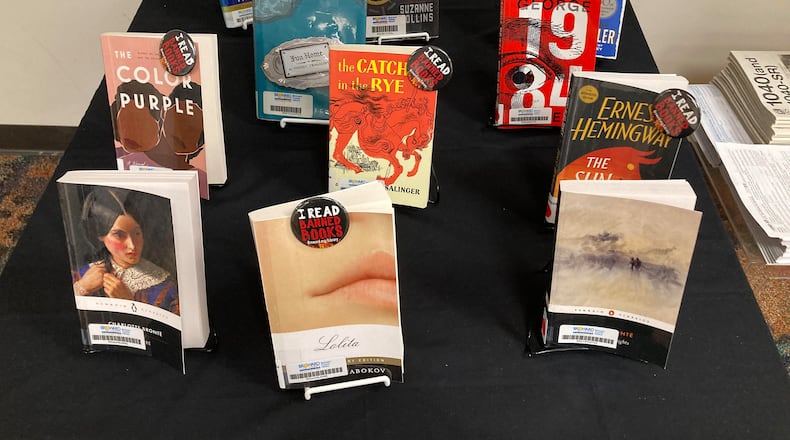Decades ago during a meeting of the Glynn County, Georgia, school board, I stood alone at a lectern and was booed by 400 people. This was rather unnerving. But it didn’t deter me or the others who were defending “The Catcher in the Rye” against a proposal to ban books with obscenities.
Back then, the vast majority who showed up wanted the ban. One of the book’s opponents even cited the number of times the main character, Holden Caulfield, says “damn.” (Holden is a teenager who desperately tries to act more grown-up than he is.)
Amazed that anyone had counted all those “damns,” a fellow teacher whispered into my ear, “This guy needs to get a life,” and the school board must have agreed. To the board’s credit, it voted to keep “Catcher” on the high school curriculum, noting there was already a policy allowing students alternate choices.
Credit: Contributed
Credit: Contributed
Today, the culture wars have only intensified efforts to keep books from students in schools and even from adults in public libraries. Although these skirmishes are all too familiar, the same important question usually goes unanswered: What gets lost when we demonize books?
This was on my mind more recently during another of my book battles. My principal forbade me from continuing to teach the Pulitzer Prize-winning novel “The Color Purple“ to all but my AP Lit students (it was on the AP reading list, so I guess that made it OK). He got worked up after a parent, whose child could have picked something else, bypassed me and complained to him that the book was “pornography.”
Despite my protests, my other classes of seniors, who were often Georgian, Black and from low-income backgrounds like the book’s characters, had to read different, lackluster stuff from then on. This was a particular blow because “Purple” was the only schoolbook most of my students had ever read from cover to cover, as far as I could tell.
This proscription persisted for years. It didn’t matter that many students had already seen the Steven Spielberg movie. Or that “The Color Purple” was on Broadway. Never mind that its author, Alice Walker, had grown up in another small South Georgia town. It made no difference that I always had sent a letter home explaining the book’s value despite its graphic opening. Or that I stressed the students’ opt-out clause (only that one parent objected). The book was toast.
When all my seniors used to read “The Color Purple,” they and their parents accepted it, I believe, because they already knew and embraced the basic story. In this widely celebrated tale, Celie, the central character, finds love, strength, hope and redemption after being demoralized and defiled. As she overcomes her challenges, the readers root for her, experience her transcendence and recognize that this is great storytelling, despite any so-called flaws.
Sigh … In the defense of books, plenty has already been written about protecting free thought, appreciation of other cultures, the need to promote understanding and empathy, the loss of imagination, of analytical skills, etc. But as somebody who has taught literature for a while, I think more about what we all lose when essential characters of American culture get erased.
I wonder what my life might have been if I had never met the supremely confident bisexual character Shug, who inspires Celie to believe that God wants people to be happy. And, Shug adds, God wants people to love the color purple, which, I now see, is everywhere.
What if I hadn’t encountered Holden Caulfield when I was an awkward teenager, who was less than enamored with school and confounded by the ways of adults?
Where would we all be without “To Kill a Mockingbird,” a book set in the Jim Crow South that gets banned because of a racial slur? Readers know that the book doesn’t condone the slur; on the contrary, it condemns all kinds of intolerance with a plot that few people can forget involving camellias, court hearings and a rabid dog that gets shot on a dirt road.
Despite the many efforts to ban this chestnut, people who read it come to regard the lawyer, Atticus, as a beacon of morality. And through the eyes of Atticus’ spunky daughter, Scout, we reconsider the status quo. As her young eyes open, so do ours. (I almost named my first daughter Scout.)
Just as essential is the joy of meeting 6-year-old Dill, who first appears in a collard patch, defending his puny size by saying “I’m little but I’m old.” He comically engineers great schemes to make a ghostly neighbor, Boo Radley, come out. But Dill is also the first to cry during a trial exposing rank prejudice and cruelty. (I did name my cat Boo.)
Although I am a 70-year-old, straight, white woman from New York, I identify with each of these characters, and they are as real to me as my family and friends. I believe they also became real to my many students. Many came to love these characters, perhaps as much as I do. What if we had never met them? How would we measure the cost?
Here’s my toast to all the writers and readers, librarians and teachers, who believe in the intangible power of stories! May they be read. Always. Because we need them.
Jan Gehorsam taught English in high schools and universities in South Georgia and Maryland. Retired on St. Simons Island, she is now writing a book.
About the Author
Keep Reading
The Latest
Featured



